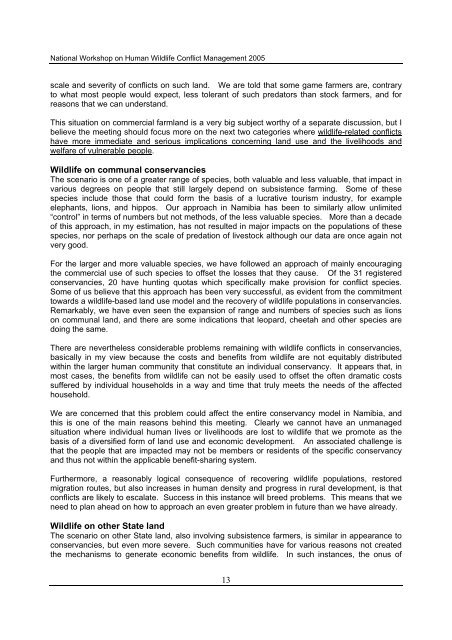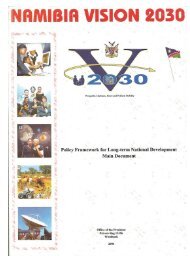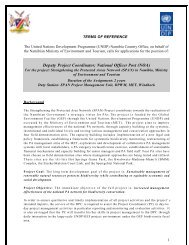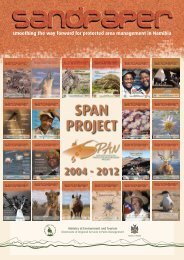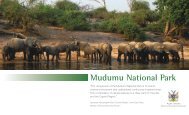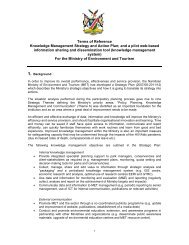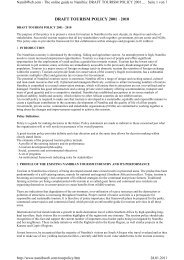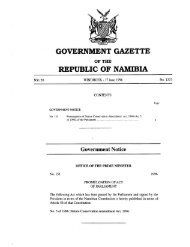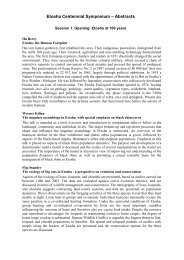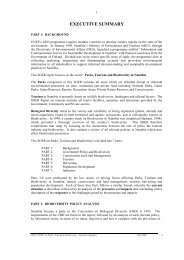HWCM - Ministry of Environment and Tourism
HWCM - Ministry of Environment and Tourism
HWCM - Ministry of Environment and Tourism
Create successful ePaper yourself
Turn your PDF publications into a flip-book with our unique Google optimized e-Paper software.
National Workshop on Human Wildlife Conflict Management 2005<br />
scale <strong>and</strong> severity <strong>of</strong> conflicts on such l<strong>and</strong>. We are told that some game farmers are, contrary<br />
to what most people would expect, less tolerant <strong>of</strong> such predators than stock farmers, <strong>and</strong> for<br />
reasons that we can underst<strong>and</strong>.<br />
This situation on commercial farml<strong>and</strong> is a very big subject worthy <strong>of</strong> a separate discussion, but I<br />
believe the meeting should focus more on the next two categories where wildlife-related conflicts<br />
have more immediate <strong>and</strong> serious implications concerning l<strong>and</strong> use <strong>and</strong> the livelihoods <strong>and</strong><br />
welfare <strong>of</strong> vulnerable people.<br />
Wildlife on communal conservancies<br />
The scenario is one <strong>of</strong> a greater range <strong>of</strong> species, both valuable <strong>and</strong> less valuable, that impact in<br />
various degrees on people that still largely depend on subsistence farming. Some <strong>of</strong> these<br />
species include those that could form the basis <strong>of</strong> a lucrative tourism industry, for example<br />
elephants, lions, <strong>and</strong> hippos. Our approach in Namibia has been to similarly allow unlimited<br />
“control” in terms <strong>of</strong> numbers but not methods, <strong>of</strong> the less valuable species. More than a decade<br />
<strong>of</strong> this approach, in my estimation, has not resulted in major impacts on the populations <strong>of</strong> these<br />
species, nor perhaps on the scale <strong>of</strong> predation <strong>of</strong> livestock although our data are once again not<br />
very good.<br />
For the larger <strong>and</strong> more valuable species, we have followed an approach <strong>of</strong> mainly encouraging<br />
the commercial use <strong>of</strong> such species to <strong>of</strong>fset the losses that they cause. Of the 31 registered<br />
conservancies, 20 have hunting quotas which specifically make provision for conflict species.<br />
Some <strong>of</strong> us believe that this approach has been very successful, as evident from the commitment<br />
towards a wildlife-based l<strong>and</strong> use model <strong>and</strong> the recovery <strong>of</strong> wildlife populations in conservancies.<br />
Remarkably, we have even seen the expansion <strong>of</strong> range <strong>and</strong> numbers <strong>of</strong> species such as lions<br />
on communal l<strong>and</strong>, <strong>and</strong> there are some indications that leopard, cheetah <strong>and</strong> other species are<br />
doing the same.<br />
There are nevertheless considerable problems remaining with wildlife conflicts in conservancies,<br />
basically in my view because the costs <strong>and</strong> benefits from wildlife are not equitably distributed<br />
within the larger human community that constitute an individual conservancy. It appears that, in<br />
most cases, the benefits from wildlife can not be easily used to <strong>of</strong>fset the <strong>of</strong>ten dramatic costs<br />
suffered by individual households in a way <strong>and</strong> time that truly meets the needs <strong>of</strong> the affected<br />
household.<br />
We are concerned that this problem could affect the entire conservancy model in Namibia, <strong>and</strong><br />
this is one <strong>of</strong> the main reasons behind this meeting. Clearly we cannot have an unmanaged<br />
situation where individual human lives or livelihoods are lost to wildlife that we promote as the<br />
basis <strong>of</strong> a diversified form <strong>of</strong> l<strong>and</strong> use <strong>and</strong> economic development. An associated challenge is<br />
that the people that are impacted may not be members or residents <strong>of</strong> the specific conservancy<br />
<strong>and</strong> thus not within the applicable benefit-sharing system.<br />
Furthermore, a reasonably logical consequence <strong>of</strong> recovering wildlife populations, restored<br />
migration routes, but also increases in human density <strong>and</strong> progress in rural development, is that<br />
conflicts are likely to escalate. Success in this instance will breed problems. This means that we<br />
need to plan ahead on how to approach an even greater problem in future than we have already.<br />
Wildlife on other State l<strong>and</strong><br />
The scenario on other State l<strong>and</strong>, also involving subsistence farmers, is similar in appearance to<br />
conservancies, but even more severe. Such communities have for various reasons not created<br />
the mechanisms to generate economic benefits from wildlife. In such instances, the onus <strong>of</strong><br />
13


